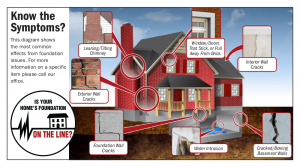Foundation Damage Miami

Foundation Damage Miami: water is the #1 driver of structural distress across coastal Miami. Storm downpours, Biscayne Aquifer spikes, and king-tide/ surge events raise hydrostatic pressure, wash out soils, crack slabs, push walls out of plane, and damage interior finishes. Catch small clues early—costs rise as moisture and movement accumulate.
1) How Water Causes Foundation Damage (Miami)
- Hydrostatic pressure: saturated coastal soils press laterally on CMU/concrete walls → cracking, bowing, seepage.
- Soil loss & voids: runoff “piping” removes fines beneath footings/slabs → differential settlement and floor drops.
- Expansion ↔ contraction: wet–dry cycles push on walls, then withdraw support → stair-step cracks and gaps.
- Moisture migration: vapor through slabs/joints → efflorescence, wood cupping, adhesive failure, moldy odors.
Local resources:
Miami-Dade Flood Zone Maps ·
City of Miami Stormwater Master Plan ·
Miami Beach King Tides ·
USGS Groundwater (FL) ·
NWS Miami Climate
2) Foundation Damage Warning Signs
Interior (1–7 quick checks)

- Doors/windows stick or won’t latch
- Cracks in floors, drywall, or ceilings
- Uneven or sloping floors
- Baseboards/crown pulling away from walls
- Water stains, musty odors, or visible mold
- Efflorescence on tile/concrete
- Bowing or leaning interior walls
Exterior (1–7 ground checks)
- Foundation/brick/stucco cracks (stair-step at corners)
- Gaps around doors/windows; trim separating
- Standing/flowing water near slab after rain or king tides
- Negative grade toward the house
- Spalling/chipping concrete along slab edges
- Mildew growth at the base of walls
- Tilting chimney or garage columns
If you note 2+ items on any list, schedule a professional inspection.
3) Timeline of Damage Progression
- 0–24 hours: heavy rain or tides spike soil moisture; lateral pressure rises; seepage appears at joints/cold seams.
- 1–7 days: ponding at slab edges; hairline cracks; doors begin to bind; musty odors develop.
- 30–90 days: measurable settlement/heave; floor cupping or tile pop; efflorescence spreads.
- 6–12 months: movement “locks in”; repair scope/cost escalate without drainage control.
4) Solutions That Stop Water-Driven Damage
- Drainage engineering: regrade, extend downspouts (10–15 ft), add perimeter drains; route discharge away from the foundation.
- Waterproofing assemblies: membranes/coatings, interior channels, sump systems, and vapor control to protect slabs, walls, and finishes.
- Piering & pressure grouting: re-support settled areas, bridge voids, and stabilize footings.
- Moisture management indoors: dehumidification, sealed crawlspaces, and flooring systems rated for slab moisture.
Learn more:
Drainage Problems (design & fixes) ·
Foundation Waterproofing ·
Foundation Repair
Engineered Solutions for Water-Driven Foundation Damage in Miami
Miami’s ultra-high water table, porous limestone base, and intense hurricane rainfall create some of the most challenging conditions for foundations in Florida. Our team, led by water hydraulics engineer Jeff Earl, approaches every repair by first controlling the water that drives settlement, slab cracking, and wall movement. We combine advanced drainage design, below-grade waterproofing assemblies, and structural stabilization to keep Miami homes and commercial buildings stable even in the toughest flood and storm events.
Protecting Property Value & Avoiding Escalating Repairs
Ignoring early warning signs — sticky doors, stair-step cracks, or water ponding at slab edges — can allow 2–3 inches of settlement in just a decade and accelerate steel corrosion by up to 40%. Once movement “locks in,” repairs become more complex and costly. Our engineered solutions stop hydrostatic pressure before it worsens structural damage, and most installations come with a Lifetime Transferable Warranty to protect both your home and its resale value.
Miami Foundation Damage & Waterproofing FAQ
Does the Florida Building Code require basement or foundation waterproofing?
No. The Florida Building Code (FBC) does not have dedicated standards for below-grade waterproofing. In Miami-Dade County — where the water table is extremely high and ground is often porous limestone — foundations must be designed almost like “building a boat” below sea level to resist continuous hydrostatic pressure, even though this isn’t written into the code.
Do I need a building permit to waterproof or improve drainage around my foundation in Miami?
No. Standard drainage systems, sump pumps, and waterproofing work do not require a building permit in Florida. Only structural modifications — such as reinforcing or rebuilding foundation walls — would trigger permitting in Miami-Dade County.
How much can it cost to repair and waterproof a foundation in Miami?
Comprehensive water-driven foundation repair and waterproofing typically costs $20,000–$40,000 depending on groundwater depth, soil type, and the scope of stabilization required. Acting early — before major structural movement occurs — helps avoid higher repair costs later.
Can a Miami foundation remain stable with such a high water table?
Yes — but only if water control comes first. Properly engineered systems combine drainage planning, sump discharge, heavy sealing membranes, and, where needed, structural measures like piers or pressure grouting. With the right design, even in Miami’s saturated soils and hurricane rainfall, a foundation can remain dry and structurally sound long-term.
5) Request Your Free Miami Foundation Evaluation
- Call (813) 614-4830 or book online
- We review drainage, grading, and structure; map moisture and movement
- Receive a written plan with photos and a lifetime-warranty proposal
Additional reading:
Miami-Dade Flood Maps ·
FEMA Flood Maps
